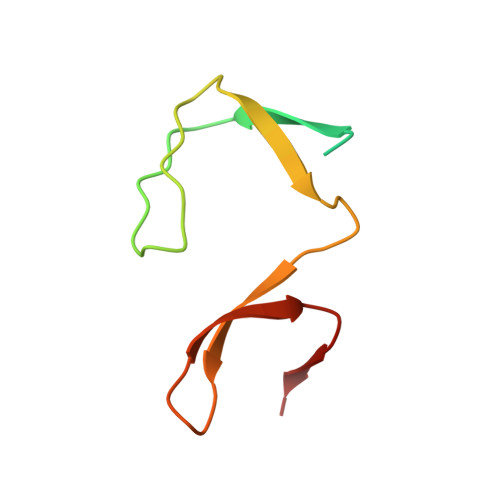Small molecule AX-024 reduces T cell proliferation independently of CD3ε/Nck1 interaction, which is governed by a domain swap in the Nck1-SH3.1 domain.
Richter, K., Rufer, A.C., Muller, M., Burger, D., Casagrande, F., Grossenbacher, T., Huber, S., Hug, M.N., Koldewey, P., D'Osualdo, A., Schlatter, D., Stoll, T., Rudolph, M.G.(2020) J Biol Chem 295: 7849-7864
- PubMed: 32317279
- DOI: https://doi.org/10.1074/jbc.RA120.012788
- Primary Citation of Related Structures:
5QU1, 5QU2, 5QU3, 5QU4, 5QU5, 5QU6, 5QU7, 5QU8, 5QUA - PubMed Abstract:
Activation of the T cell receptor (TCR) results in binding of the adapter protein Nck (noncatalytic region of tyrosine kinase) to the CD3ϵ subunit of the TCR. The interaction was suggested to be important for the amplification of TCR signals and is governed by a proline-rich sequence (PRS) in CD3ϵ that binds to the first Src homology 3 (SH3) domain of Nck (Nck-SH3.1). Inhibition of this protein/protein interaction ameliorated inflammatory symptoms in mouse models of multiple sclerosis, psoriasis, and asthma. A small molecule, AX-024, was reported to inhibit the Nck/CD3ϵ interaction by physically binding to the Nck1-SH3.1 domain, suggesting a route to develop an inhibitor of the Nck1/CD3ϵ interaction for modulating TCR activity in autoimmune and inflammatory diseases. We show here that AX-024 reduces T cell proliferation upon weak TCR stimulation but does not significantly affect phosphorylation of Zap70 (ζ chain of T cell receptor-associated protein kinase 70). We also find that AX-024 is likely not involved in modulating the Nck/TCR interaction but probably has other targets in T cells. An array of biophysical techniques did not detect a direct interaction between AX-024 and Nck-SH3.1 in vitro Crystal structures of the Nck-SH3.1 domain revealed its binding mode to the PRS in CD3ϵ. The SH3 domain tends to generate homodimers through a domain swap. Domain swaps observed previously in other SH3 domains indicate a general propensity of this protein fold to exchange structural elements. The swapped form of Nck-SH3.1 is unable to bind CD3ϵ, possibly representing an inactive form of Nck in cells.
Organizational Affiliation:
I2O Disease Translational Area, pRED Pharma Research and Early Development, Roche Innovation Center Basel, F. Hoffmann-La Roche Ltd., Grenzacherstrasse 124, 4070 Basel, Switzerland.














